Text
Congratulations Nier Automata sound team for winning best score/music at The Game Awards! Heavy competition this year but you had my vote.
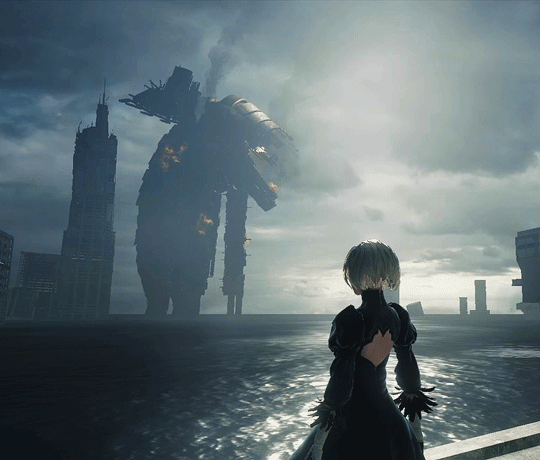
#Thegameawards#square enix#platinum games#video game music#video games#Soundtrack#Nier#nier automata#Vga#playstation#ps4#Yoko taro
50 notes
·
View notes
Link
oh, mama
#nier#nier automata#2b#yorha 2b#video games#vgm#videogame soundtrack#soundtrack#vinyl#playstation#square enix
4 notes
·
View notes
Video
Lost Planet 2 Soundtrack - Sub Theme
Dug this gem out of my soundtrack collection playlist on YouTube. An epic, fully-orchestrated theme that makes great use of brass.
#lost planet#video games#capcom#lost planet 2#ochestra#vgm#soundtrack#video game music#ost#playstation#epic
11 notes
·
View notes
Photo

Congratulations Nier Automata sound team for winning at CEDEC!!
#cedec#video games#nier automata#2b#vgmusic#soundtrack#video game music#square enix#platinum games#playstation#Nier#9s#yorha 2b
45 notes
·
View notes
Audio
I’m inclined to agree. Superb use of strings
One of the greatest compositions I’ve heard in my life
3K notes
·
View notes
Text
Bloodborne Soundtrack Review
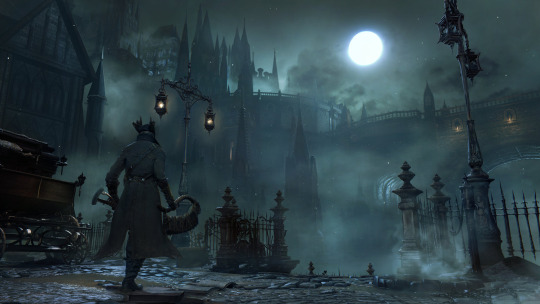
Bloodborne’s soundtrack is not for everyone. The eerie sensation that perpetuates it often produces uncomfortable sounds, and for that reason it may put you off, at least before you gain the necessary...insight. Like the game itself, things are seldom as they seem. Underneath the screeching, disjointed notes is a majestic, diverse soundtrack unlike any other. Bloodborne’s soundtrack is another shining example of classical composition in videogame music. For those seeing a completely unspoiled experience, look away, because some of the boss themes may give away certain things. Otherwise, plunge yourself into the darkness.
youtube
You know you’re not in for a good time when the track listing begins with a piece called “Omen.” The track begins with the boom of a concert bass drum, reminiscent of the beginning of the Demon’s Souls main theme. Unlike its predecessor, however, the piece follows with a slow, brooding cello, setting the overall dark background that permeates the soundtrack; in contrast to Motoi Sakuraba’s (桜庭 統) grandiose use of brass in Dark Souls, lead composer Ryan Amon only uses brass to accentuate certain notes and to reach low ranges of the audio spectrum where strings could not.
That said, strings do take the forefront of Bloodborne, an appropriate choice considering the game’s pseudo-Victorian England setting. The bass strings advance to a steady march, and when the lone vocalist begins her somber note, you know you are once again subject to From Software’s twisted sense of beauty. “Omen” is very much a, ah...microcos, or some say microcosm of the entire soundtrack, demonstrating Ryan Amon’s emphasis on strings and vocals, with recurring disjointed escalating notes reminiscent of horror movies.
youtube
Amon also sets himself apart from Sakuraba and Shunsuke Kida (木田 俊介 ) of Demon’s Souls fame by introducing tempo shifts in several tracks. “The Night Unfurls” in particular is one of my favorite tracks. The vocalist starts slow and soft, but strings escalate the piece to a higher octave, leading the vocalist to a shrill note. “The Night Unfurls” has a clear intro, rise, apex, denouement, and end, unlike most looping tracks in the Souls series. Many of Bloodborne’s tracks are similar in this regard, making each piece a self-contained movement. The theme brightening at 1:10, the minor key at 1:27, and my favorite bit, the lead violinist’s chilling performance of the single F# con affetto (with emotion) at the 1:37 mark. That last one never fails to send chills down my spine.
youtube
Bloodborne is yet another FROM SOFTWARE game chock-full of action-packed sequences, and its composers have continued the lineage of epic classical compositions that began with Demon’s Souls. “The Hunter” is a prime example, making great use of tempo shifts that match the boss’ transformations. This piece really stands out from the rest of Amon’s compositions for its use of brass. The heavy-handed brass combines with the strings’ and bass drum’s relentless pacing, making the encounter truly intimidating. The effect is further amplified around 1:45 when the tempo speeds up affrettando (in a rushing manner) and strings take center stage. At 1:55, the song shifts into a higher key and introduces even more levels into the piece; almost overwhelming, but in truth a beautifully controlled chaos. At 2:19 the chorus’ 5-note motif brings the song to a terrifying crescendo. “The Hunter” is undoubtedly one of the best tracks in recent videogame history, as its composition wonderfully complements the boss. The theme is a prime example of the soundtrack being an integral part of game design, showcasing the incredible attention to detail from both FROM SOFTWARE and Ryan Amon.
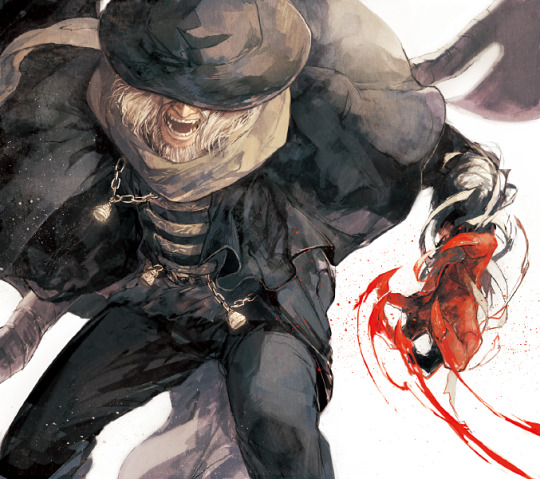
Art by Yoshioka (Haco) http://haco11.tumblr.com/
youtube
The action tracks in Bloodborne weren’t simply filled with unending terror, thankfully, as it has its fair share of grandiosity as well. “Ebrietas, Daughter of the Cosmos” from Souls veteran Yuka Kitamura (北村 友香) was perhaps the grandest of all. The slow tempo of the solemn Latin hymn and the steady pace of the drums feels very much like a procession march. As soon as it escalates at 0:32, however, the strings bring about a feeling of vastness, and the brass accompanies with a sensation of grandness. That strings, escalating ever higher, paint an image of a immense, galaxial place without bounds, whereas the brass depicts the awe of communing with something on a higher level. By 1:28, the tempo picks up again but contains a hint of sorrow; the minor key makes the theme sound like it came straight out of a tragic opera. The main chorus proceeds almost angelically near the beginning, but by 1:45 the theme grows increasingly desperate; the song becomes a holy song of praise and also a dirge at the same time. Tuplet notes at 2:23 and minor keys at 2:58 and 3:01 respectively deepen this sensation. At 3:12, the track reaches an apex on a major key, but soon falls and slows. The fermata (grand pause) for a full beat at 3:33 and half beat at 3:39 gives incredible strength to the emphatic final crescendo. “Ebrietas” is sublime because, despite being a boss theme, awe and tragedy have replaced terror. “Ebrietas” is awesome in the literal sense of the word.
youtube
The final track that really elevated the soundtrack for me was Tsukasa Saitoh’s (斎藤 司) “The First Hunter.” The slow strings performed a sad melody that reminds me of the classic “Adagio For Strings” by the late Samuel Barber. This piece was really strange to me because of its emotional depth; the boss itself has a whole backstory I completely missed (due to the dreaded chance-based encounters), so I initially did not understand the reason for the track’s dramatic performance. Upon seeing the encounter and one of the endings, however, I slowly saw why. “The First Hunter” is very much the “Gwyn, Lord of Cinder” of Bloodborne, depicting a similar idea of being reduced to a shadow of your former self while watching your world die slowly. I am ashamed that I don’t have more words for this beautiful piece, only to say that, if you can appreciate classical music in the very slightest, then you should listen to this theme.
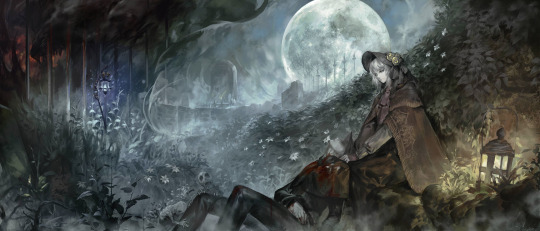
By alcd on Pixiv https://www.pixiv.net/member.php?id=2334059
On the softer side of things, “Hunter’s Dream” and “Moonlit Melody” are more similar to Souls songs of old, and for good reason. FROM SOFTWARE has often put emphasis on a “home” location: The Nexus from Demon’s Souls, Firelink Shrine to a degree in Dark Souls, Majula in Dark Souls II, and now Hunter’s Dream in Bloodborne. Each of these locales is a rare, safe haven for the player character, a bulwark against the rest of the terrible worlds out to end you. Both “Hunter’s Dream” and “Moonlit Melody” only feature strings and a solo vocalist playing a simple, beautiful, memorable melody. These two tracks are very much in tune with the previous Souls home themes in that players will not tire of their soft, calming effects; they do not utilize the tempo shifts like other pieces in lieu of stability and familiarity, both essential traits of home themes. By including both stable and variable-tempo songs, Ryan Amon and co. introduce flexibility not only to the individual tracks, but also to the entire soundtrack itself.
This review only covered some of my favorite tracks, but some others deserve a listen as well. The timpani performance at last third of “Amygdala.” The Eerie strings opening of “Celestial Emissary.” And, of course, the titular “Bloodborne” in its full glory, completing the twisted journey that “Omen” began. I still stand by what I said in the beginning in that Bloodborne’s soundtrack is not for everyone, but if you have an interest in dark, grand orchestral compositions---something you’d listen to while reading Lovecraft---or simply that you have played Bloodborne, then I highly, highly recommend it.
The Old Hunters DLC Soundtrack Review will arrive soon.

#Bloodborne#Dark Souls#Soulsborne#SCEJ#Sony#Playstation#Soundtrack#VGM#OST#VGOST#horror#Lovecraft#review#soundtrackreview#music review#from software#video games
98 notes
·
View notes
Text
Persona 5 Soundtrack Review
The Soul of Style
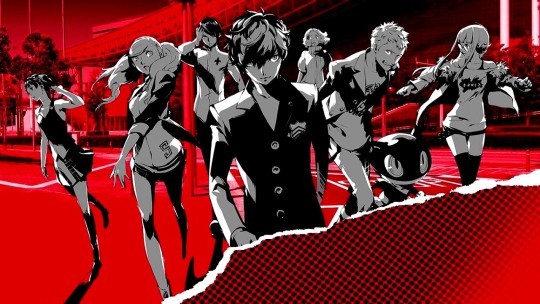
Persona fans had been waiting for Shoji Meguro (目黒将司) for eight years, the long eight years between Persona 4 and the long-awaited release across two generations, Persona 5. Meguro had risen to widespread prominence with the Persona 3 soundtrack, a refreshing compilation of US pop and J-pop; to this day, it remains among my favorite gaming soundtracks. Persona 5 was a runaway hit upon release both in Japan and globally, bringing the unique, stylish mix of JRPG and Visual Novel to a worldwide audience. The only question remains: has Meguro recreated the musical success of his previous works?
Packaging and Design

Wow. Just…wow. For a series exuberant with style, with P5 being arguably the most stylish entry thus far, the physical copy did not disappoint. Few soundtrack packages wow me, but this one has got to be one of the best things in my collection.

Each of the three CDs were adorned with the bombastic artwork from Shigenori Soejima (副島 成記). The sheen and superb print quality made them feel like collector’s items.

The treasure in this palace*, however, was the booklet. I was glad to see the trend of increasingly detailed booklets in physical soundtracks; this one had a great deal of behind-the-scenes material. Booklets like these add so much value to the soundtrack.
*I’m sorry



It’s got lyrics to all the vocal tracks. Also, more of Soejima’s amazing artwork.

This…this was the Inception-level treasure inside the treasure inside the Palace. The composers’ commentary on quite a few tracks that spans two spreads. Plus, this spread features best (party) girl. (I went with Hifumi #sorrynotsorry)
The soundtrack is available digitally for $29 (on iTunes, at least) but I highly, highly recommend the physical copy of the soundtrack for its incredible value and insight into the music.
Soundtrack Review
This soundtrack is three discs of Acid Jazz Bliss. The genre, being a mix of jazz, soul, funk and disco, defines Persona 5. The series features themes of duality: with P3, life and death, P4 being deception and revelation; P5′s is injustice and freedom. As such, the soundtrack for each entry needed tonal diversity for the scenarios in their respective thematic spectrums. It may be that jazz was inevitable, given traditional associations between jazz and gentlemen thieves like Lupin III (which the game references often) and Ocean’s Eleven. Considering that Acid Jazz had slowly faded out near the end of the 90s, Meguro’s choice was surprising. Nevertheless, the genre as a musical theme to P5 was a damn near perfect choice—the soul and funk aspects of the genre allowed for Meguro to capture the essence of the “melancholy”* and “unrefined/not-yet-mature”* nature of the protagonist and, consequently, the game.
The defining example of this slow-burning, bluesy emotion was my favorite track, “Beneath the Mask.”
youtube
This theme and its permutations was the nighttime theme of P5, playing whenever the protagonist returned home to cafe LeBlanc. Performed in a melancholic G Minor, the slow jam of this theme stylishly captured the emotion of winding down when one finally gets home after a day’s work. The two defining instruments of the soundtrack—namely, the bass and the electric piano—sets the slow, smooth swing of this theme. Lyn, the stunning vocalist of the soundtrack, shows off her fantastic range and nuance in this track. She begins with a soft, conversational tone in the midrange, rising to the main motif “I’m a Shapeshifter…” in the treble G with a held-back falsetto, then dropping down to the Contralto G as the motif section ends. “Beneath the Mask” dances between Lyn and the instruments taking the lead, making for a superb background theme that I never tire to listen to. The lyrics, too, made for a wonderfully forlorn piece:
I’m a Shapeshifter At Poe’s masquerade Hiding both face and mind All free for you to draw I’m a Shapeshifter Have no face to show Please don’t take off my mask Revealing dark
I suspect that, had another composer-vocalist combination attempted the piece with these lyrics, it would have been too campy. But Meguro’s composition and Lyn’s dynamic Contralto voice sculpted it into a beautiful slow jam. I am a huge fan of Lyn’s trail-off on the word “shapeshifter” at 3:42—that little touch gives this theme so much more soul.
Meguro commented on this piece:
“Of all the vocal tracks we have made, Lyn’s performance was my favorite in this one. Also, her singing ability was really amazing. The shuffle (swing) tempo made this a really difficult piece to sing, but she shone through.”*
*Shoji Meguro, Persona 5 Soundtrack Booklet
Other noteworthy slow pieces in the OST are “Confession/Secret,” a theme filled with low-key emotional tension brought on by the drums while being encapsulated by a methodic distortion, and “Alleycat,” which was led by two different styles of electric piano. The latter actually reminds me of old Japanese TV dramas because of how melodramatic it was, but quite fitting, given the scenarios it played in. “Sunset Bridge” also served as an excellent accompanying piece to the denouement of each story arc. With these pieces in the soundtrack, Meguro has shown his mastery of the electric piano. The sound of the instrument is almost always soft, but he created these calm pieces with their own nuances to fit their respective scenarios.
Above all, the soundtrack is chill and sassy. Given that a great deal of Persona titles take place in visual novel sequences, it became paramount to engage the player with the feeling of the setting. Luckily, like P3 and P4 before it, Meguro succeeded with flying colors once more, P5 perhaps being the best due to its thematic consistency.
Acid Jazz allows for flexibility in the intensity of different tracks while tying them together with a thematic overtone. “Break it Down,” for instance, played Marcia Moderato (~85bpm) and “My Homie,” played Andante (~75bpm) at different scenarios while hanging out with friends, as different tempots are required for their respective levels of activity. Even classroom-related themes like “Is It Boring” and “Life Goes On” were not, well, boring, though I found myself wondering why I stressed out over taking goddamn tests in a game after I had graduated my schooling in real life.
An interesting musical element that occurs throughout these themes as well as many tracks, by the way, was the use of grace notes, when a note is played immediately next to another that is not accounted for in the bar note tempo. Grace notes are a staple in different types of blues and jazz, allowing for more improvisation, fluidity, and freedom. Fitting, then, for “freedom” was one theme of Persona 5.

I miss these guys. Source: https://www.pixiv.net/member_illust.php?mode=medium&illust_id=59685294
Furthermore, the disco and funk elements of Acid gives power to higher-intensity tracks. “Tokyo Emergency” draws a convincing picture of the metropolitan rush in the capital city; from the nonstop swarm of orderly pedestrians to the maze-like train stations, the theme captures the energy of Tokyo in full funk fashion. “Layer Cake,” a personal favorite, is weird from the outset, not unlike the shady in-game airsoft store “Untouchable” filled with an odd air the moment you step in it. The ominous intro with the spider-like accompanying rhythm in the background and discordant four-note structure creeped me out, but quickly settled into a rhythmic jam led by the guitar and bass, revealing the owner’s passion and expertise under a hardened exterior.
youtube
The key themes of the soundtrack, however, really…uh…stole my heart*. “Wake Up, Get Up, Get Out there” was the first theme from Persona 5 heard around world upon its trailer debut. From then on I knew P5 to be another top-tier soundtrack. This track starts with simple opening with just three instruments, an elevation by the synth strings, followed by Lyn’s powerful voice. This theme, along with “Life Will Change,” forms a two-movement structure that encapsulates the theme and aesthetics of Persona 5. The realities of life are often a source of disillusionment for young adults—corruption, exploitation, all fueled by greed—and the party members of the game were no exception. But the youthful energy of this musical motif marvelously brought forth the ultimate message of Persona 5: not “life might change,” not “life can change,” but “Life WILL change” upon us putting ourselves out there.
As a (relatively) young person who has seen his fair share of woes in the world, the negativity of the world gets me down sometimes. But P5 reminded me that, as long as I still draw breath, I can do something about it. Life is what we make of it, so make the most of it.
*I’m sorry
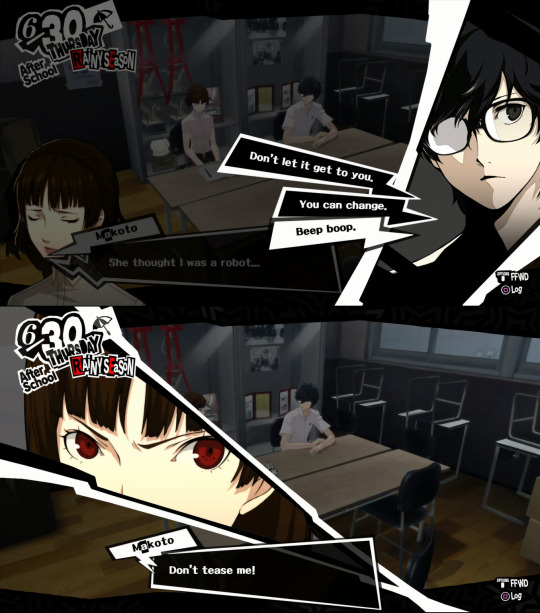
And by “make the most of it,” I meant doing this to your SO.
The battle theme “Last Surprise” was also yet another superb fight track from Meguro. It was so good, I almost never saw it coming*. Lyn really shone in this piece for her unbeatable vocal range. She began with an almost conversational tone with swing, then quickly rose to her full strength upon all instruments coming to a full stop, entering the main motif, then softening with the lyricless “oooooh”s. The three sections made for excellent loops, which lessen the monotony of repetition.
*I’m sorry
Pieces of Meguro’s distinct personal style of rock still pepper throughout the soundtrack. The miniboss theme “Will Power” and the boss theme “Blooming Villain” are both very Meguro-rock, with a strong lead-up and distinct main motif carried by the riff. Meguro said of “Blooming Villain” in particular that he liked the “ta-ta-ta-ta” (four-beat drum tuplet) coupled with the guitar. An interesting piece as almost each bar of the first movement was defined by this drum tuplet and shaped the very melody itself.
youtube
A Persona (and Meguro, for that matter) signature, nonetheless, is an awesome final boss battle theme, and the flagship for all the action pieces in P5 did not disappoint. “Rivers in the Desert” carries with it all the weight and momentum of the decisive moment. Carrying the tradition since P3, the primary antagonist (often the second-to-last boss) is the main fulcrum of conflict. The False Messiah from 3, the real murderer from 4, and now with 5, the encounter was the most personal out of all of them, for injustice was wrought upon the player on an intimate level. “Rivers in the Desert” elevates that climax to a new degree; the namesake of the song harkens back to the theme of “Life Will Change,” and the way the party changes lives is by bringing humanity to a place seemingly desolate of it. Not only that, but the lyrics illustrate the mindset of the protagonist in the first person:
I’m keeping the balance, but I’m standing on razor’s edge now Move quick, or my life is over One strike, just a feint, then… I’m outta his field of vision
Meguro gave more praise to Lyn for this piece, stating that the A Major was difficult to perform in along with the five-track instruments as well as the chorus. “Rivers in the Desert” is a beautiful combination of instruments, lyrics, and Lyn’s voice. Even though it doesn’t quite hit the heights of “Battle for Everyone’s Souls” from P3 for me, it is certainly a magnificent boss theme.
I have two very minor gripes with the soundtrack, the first being its mixing. For the Acid Jazz genre and performance of the bass (instrument), the lower end of the audio spectrum probably should have been more pronounced. I have to clarify that I am not a fan off exaggerated, bloated bass a la early Beats headphones, but in several P5 tracks the midrange is a little overwhelming when an extension towards the lower end would have been more appropriate. The electronic piano and other synth elements are often dominant in the midrange; the bass and parts of the percussion gets lost in that sound range, and mixing it “true” as it did rendered some tracks that are supposed to be heavier ended up a little less impactful. This is, however, minor, and most audiophiles will prefer this mix as the treble is preserved for percussion and Lyn’s vocals. For a home theater system with a dedicated, powered amplifier, I would recommend finding a good LFE crossover point in which the “twang” of the bass hits the activation and leave everything else for a more impactful experience. That is not to say to listen to this soundtrack with headphones or speakers that overexaggerate the bass, as the treble will fall off a cliff on those systems, losing the fidelity of Lyn’s performances.
The second is a series soundtrack staple and not necessarily in a good way, and that is the pronunciation of English in some of the lyrics. Shoji Meguro had been concerned about it since P3, with an embarrassing mistake in P4 (”give a shit” instead of “give a shot” in “Signs of Love;” this is remedied in the Persona 4 Dancing soundtrack). However, Lyn does an incredible job most of the time, and I don’t blame her for the very minor instances in which this happens in P5, as the tempo for some of these songs are indeed difficult.
It’s difficult to write about a soundtrack that has 104 tracks, but one thing is clear: the Persona 5 Original Soundtrack is a must buy for any Persona 5 fan and otherwise those who enjoy Acid Jazz. The value of the soundtrack is excellent with the insightful booklet and fantastic artwork. The soundtrack’s recording quality, bar my small complaint, records the performances in impeccable detail; “Wake Up, Get Up, Get Out There” deserves to be listened to in 24-bit fidelity. Most importantly, the consistent quality of the songs in the soundtrack has made it one of Shoji Meguro’s best works. On a side note, I was surprised to learn that Lyn herself said that P5 was not only her first foray into the Persona universe, but also her first soundtrack recording. All of her performance carry with it a sense of confidence, bombast and professionalism hard to find in vocals. I look forward to seeing her return to vocal work in soundtracks.
Now get out there and steal some hearts, everyone. Or maybe go to bed, I dunno.

Credit: @pipi_gogo
The soundtrack can be found digitally on iTunes and the hard copy from Amazon and Amazon JP. I purchased the copy for myself and this review is not associated with Atlus, SEGA, nor any of the aforementioned companies.
#persona5#soundtrack#music#persona#shoji meguro#gaming#soundtracks#vgm#vgmusic#ost#video games#playstation#ps4#ps4 game#anime
8 notes
·
View notes
Text
Nier: Automata OST Review
Echoes of What’s Left of Us, and of Them
Mild spoilers to follow.

Keiichi Okabe (岡部啓一) and team MONACA had a great deal to live up to, namely their masterpiece that was the Nier: Gestalt & Replicant soundtrack from 2010. Theirs was already a titanic feat—finding the right thematic approach to the Yoko Taro’s insanity must have been immensely difficult. Despite that, the soundtrack to Nier was a runaway hit; it has become one of my top ten soundtracks ever.
So, does Nier: Automata’s OST deliver?
Packaging and Design

The 3-disc set is enclosed by the game’s fantastic artwork.
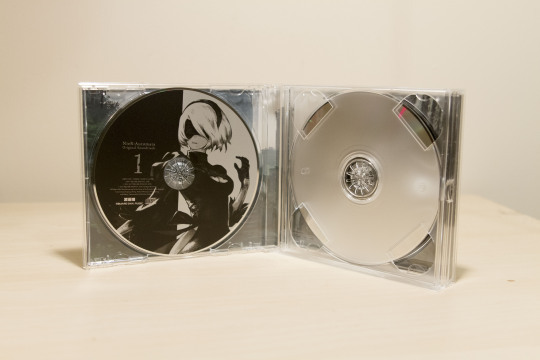
Disc One has Toobie 2B’s 2Bootiful form etched on its surface. Discs Two and Three are next to each other and are 9S and A2, respectively. Granted, there were “only” three protagonists, but I found it interesting that these two were put next to each other. I guess no-one dies alone, after all…

Artwork of the City Ruins in the case interior. Very nice.
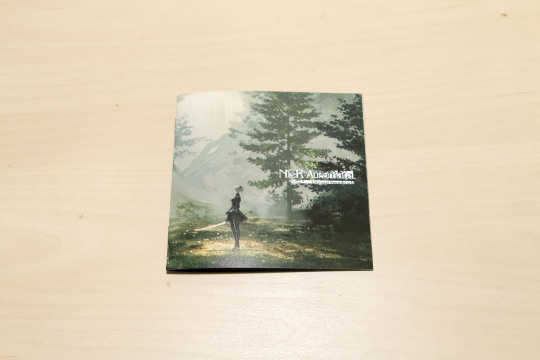
The booklet is adorned by the early concept art of 2B meeting the Forest King.

Goddamn it, Yoko Taro
On the previous page, Okabe wrote an insightful paragraph about the creation of the original Nier soundtrack and writing for Automata in its legacy (more on that later). Here, Yoko Taro gave us…this. (Plot details so I won’t include the translation)
An interesting tidbit: the track names in Japanese were written without Hiragana, instead using Kanji and Katakana entirely. The use of this linguistic trope in Japanese pop culture is often associated with the formality of technical/academic jargon, giving the track titles a��“technological,” “mechanical,” and “robotic” aesthetic. Very fitting, considering the game’s setting.
All in all, the physical copy of the soundtrack added more to its value.
Soundtrack Review
Spoilers ahead.
Upon landing in the first area (after the heart-pounding prologue), I knew I needed the soundtrack. The track is “City Ruins: Ray of Light”, which immediately set the tone of the game: seemingly desolate, yet teeming with life within. While the the first Nier OST featured mostly key pieces tied to specific characters/situations, the tracks’ in-game impact was somewhat lessened by their overuse in the game. Not so with Automata, as the soundtrack is punctuated with segmented key pieces that are amazing ambient themes, the permutations of “City Ruins” being one such example. Key pieces such as the later action themes were tied to key moments, giving them the impact and attention they deserve.
Okabe mixed acoustic instruments and synthetic sounds, bestowing each track an expansive soundstage best enjoyed on open-back headphones. Pieces like “City Ruins” were written in movements not unlike Bloodborne’s use of segments to delineate boss phases, but in Automata, the game used segments to transition between different areas in the same map. Though areas are revisited often in the game, this dynamic use of movements actually reinforced the strengths of both gameplay and music, avoiding repetition and fatigue.
Additionally, the composers wrote different variants for the motifs depending on the sequence of the game; for instance, “Significance” and the sweet, melodramatic “Vague Hope” had several versions, changing between A, B, C/D/E. Returning veteran co-composer Keigo Hoashi (帆足圭吾) composed one of my favorite tracks, “Vague Hope: Spring Rain.” The solo vocalist paired with the delicate strings delivers a highly emotional theme depicting a fragile hope…and love, or a memory thereof…

Is it OK to cry while writing a soundtrack review
One mark of a great composer is flexibility in creating diverse, memorable motifs. Okabe shows that, again, he is a master of his trade with Automata. Soft pieces like “Peaceful Sleep” have actually rocked me to restful dreams. And, befitting the soul-crushing, heart-wrenching writing under Yoko Taro’s pen, Okabe delivered the punches with genuinely disturbing tracks. “Mourning” is one such example: it began with a twisted, heavy male chorus slowly elevated by layers of female chorus, rendering the theme significantly more religious as it progressed. The female chorus briefly lessened the sorrow with major chords, only to be dragged down by the weight of the male chorus once more into a sorrowful minor key. The string quartet faded in with a solo session starting at 2:15 that reinforced the motif, and finally joined by the chorus once more at 3:18, rising to a mournful crescendo at 3:57 that was no less than an operatic processional. For the moments that warranted the use of “Mourning,”* the track absolutely killed it, and also killed my heart, hopes and dreams for the characters. *see the end of the Golden Machines sidequest
There is no lack of EPIC in Automata, and I am stoked to say that Okabe and Hoashi have written some of the best action pieces ever once more. Their flexibility came into play again, spinning a twist of action from slow, calm motifs. “War&War” was a pleasant surprise when I realized it was a battle-ready version of the obsessively calm “City Ruins” that might as well have been sung by the Red Orchestra. “End of Aliens” is almost lifted straight out of Tekken, considering the fighting-game showdown between Adam/Eve VS 2B/9S. “Alien Manifestation” by both Okabe and Hoashi is my second favorite action-track in the listing. A powerful collaboration between the two powerhouses, they employed vocals and percussion heavily influenced by Southeast Asian and South Asian music. A decidedly culturally-laden theme depicting something that was inhuman in origin yet becoming human…
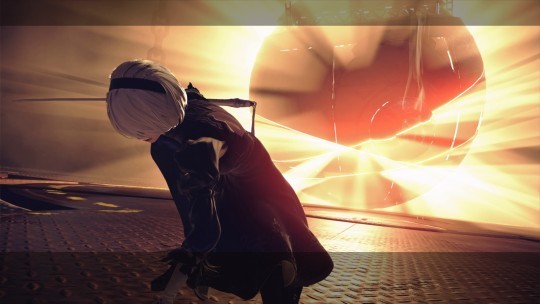
See above for EPIC
But the star amidst the shining action-tracks was “Emil: Despair.” Hoashi stole the thunder in this one, carrying on the legacy of the previous soundtrack, other examples being Okabe’s “Faltering Prayer” and “Song of the Ancients (Atonement),” but “Emil: Despair” went full SSJ3 on its already superb predecessor “Emil: Karma” from Nier. The piece is at once filled with the familiar, somber chorus, tense with weight from the Trombone, and fraught with immense sorrow driven by strings and trumpets. A new interlude, starting at 1:20, introduced a new solo vocal that demonstrates Hoashi’s brilliance in composition: introducing new ideas congruent to existing ones, bringing both to a higher place. “Emil: Despair” was truly a prime example of thus; an immensely satisfying blend of percussion-backed action and sadness.

It didn’t take eternity to hurt me, Emil
Okabe worked with amazing vocalists again. The supremely talented Emi Evans returns in key pieces to reprise her excellent performance in the first Nier soundtrack. She is flanked by newcomers J'Nique Nicole and Marina Kawano who performed the English and Japanese versions of the ending theme “Weight of the World,” respectively. Nicole’s voice had nuance and strength and was complemented by Evans’ higher, softer approach. Kawano’s performance is fairly decent although the JP version of “Weight of the World” got a little weird towards the end. I don’t know if it was from overdramatization or if Kawano was trying to emulate Nicole’s deeper vocal range, but the last vocal segment of the song seemed forced for an otherwise good performance.
Nevertheless, the vocal work in Automata’s soundtrack was among the best in the industry. The diversity in the styles of chorus for the soundtrack was particularly noteworthy; you will hear everything from solo vocals to Latin-style hymns to a style close to temple chants in South/Southeast Asian cultures, a musical style rarely found in mainstream media. This tonal diversity somehow retained the thematic consistency of the entire soundtrack, yet bringing a fresh approach to every track.

All I wanted was Metal Gear Rising with Badass Goth Lolita Androids. I did get what I wanted /and/ existential crisis, a torrent of tears, and the one of the best game soundtrack in years. Pretty good deal.
Okabe wrote in the soundtrack booklet:
[This soundtrack] is the result of spending time and thought on capturing the “essence of Nier” as well as introducing new themes to bring the new world of Nier:Automata to life.
His collaboration with Hoashi, Takahashi and Ishihama as well as the talented performers for both vocals and instruments have realized that vision and then some. Nier:Automata Original Soundtrack was yet another masterpiece befitting Yoko Taro’s madness—a bleak outlook on what it means to be human, brought about by deceit and despair, and the faint, blossoming hope rising above the carnage. The game asked if humanity could exist without humans, and the answer was a resounding “Yes.” I hope that music, being an intrinsically emotional creation, will be one of humanity’s enduring legacies in the vastness of existence. Perhaps in 10,000 years, a badass blindfolded goth lolita android will find a CD of Nier Automata’s soundtrack buried in the city ruins, and experience a glimpse of the emotions that defined us.

This soundtrack is a must own for all fans of Nier: Automata and those who enjoy action and ambient tracks. It is available digitally on iTunes and Amazon. I bought the physical copy from Amazon JP.
This review was not sponsored by Amazon, Apple, Square Enix, Platinum Games, or MONACA.
11 notes
·
View notes

